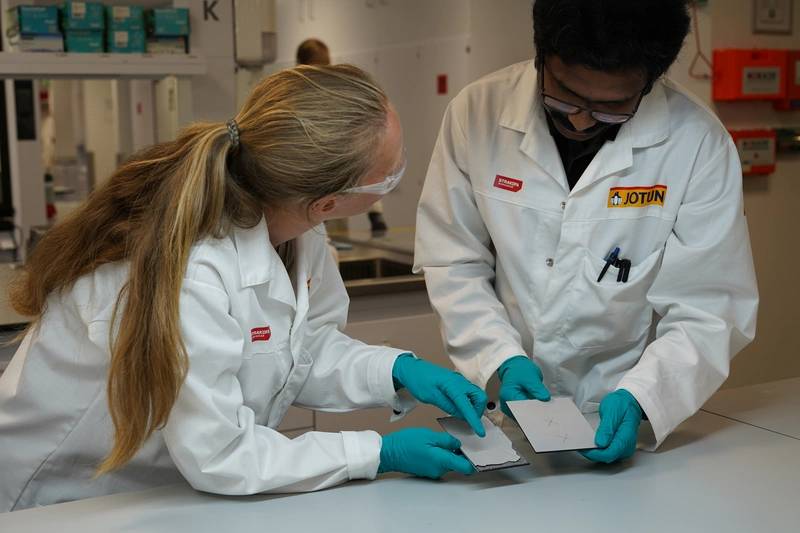But if we manage to create a greater awareness of the connection between clean hulls and decarbonization and fuel savings, I believe that we can overcome this challenge. By understanding the importance of innovative and effective solutions that also meet budgets, operational, and environmental needs, we can align all these factors in the same direction.
COP29. Christer and Jessica Doyle (Global Sales Director Shipping) participated COP29 in November 2024, and Christer was in a panel discussion related to how we better can protect biodiversity and shipping’s role into that. Image credit; Jotun
- Looking ahead, what are the key areas of focus for Jotun’s R&D team?
Looking ahead, we are focused on advancing our understanding of how coatings can contribute to decarbonization, fuel efficiency, and overall sustainability in the maritime industry. We will continue to develop technologies and solutions that provide clean hulls, reduce friction, and optimize vessel performance.
Additionally, we are committed to addressing the challenges posed by regulatory requirements and ensuring that our coatings meet the needs of shipowners in terms of budgets, operations, and the environment. By staying at the forefront of innovation and focusing on the broader impact of our coatings, we aim to lead the way in sustainable marine coatings for the future.
Author: Christer Øpstad, Global R&D Director Fouling Protection, Jotun
The Impact of Innovation and Regulation on the Shipping Industry
Innovation and regulation are two key factors that play a significant role in shaping the shipping industry. The constant evolution of technology and the enforcement of regulations create shifts and uncertainties for the entire industry, leading to a more complex dynamic and slower innovation processes.
The shipping industry is constantly facing costly demands in terms of regulations and taxes on carbon emissions, as well as other constraints on their budget. This limits their willingness to invest in new solutions and technologies that could potentially create value for them. It becomes crucial to demonstrate the worth and prove the value of innovative solutions to drive investment in sustainable practices.
One area where innovation is gaining traction is in robotic hull cleaning solutions. These technologies offer a promising opportunity to enhance the efficiency and effectiveness of hull maintenance. For example, the HullSkating solution combines coatings with robotic technologies to provide the cleanest possible hulls, even in challenging operations.
As new technologies emerge at a rapid pace, it is essential for industry players to embrace these innovations to make shipping cleaner and more sustainable. While there is no one-size-fits-all solution to the challenges posed by biofouling, having access to a variety of options allows operators to choose the most suitable solution for their specific needs.
When considering robotic hull cleaning solutions, key factors to evaluate include cost, availability, documentation requirements, and level of crew involvement. Understanding how these solutions align with operational parameters and regulatory requirements is crucial for successful implementation.
As the industry continues to adopt new technologies, there is a need for a structured approach to evaluating and implementing these solutions. Collaboration between industry stakeholders and regulatory bodies, such as the International Maritime Organization (IMO), is essential to ensure that innovations are implemented effectively and in compliance with industry standards.
Overall, the intersection of innovation and regulation in the shipping industry presents both challenges and opportunities. By embracing new technologies and sustainable practices, industry players can drive towards a cleaner and more efficient future for maritime operations.

Conclusion
The shipping industry is at a critical juncture where innovation and regulation are shaping its future. By investing in sustainable practices and embracing new technologies, industry players can overcome challenges and drive towards a more efficient and environmentally friendly shipping industry.

